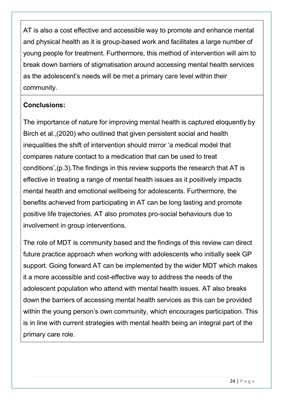
24 | P a g e
AT is also a cost effective and accessible way to promote and enhance mental
and physical health as it is group-based work and facilitates a large number of
young people for treatment. Furthermore, this method of intervention will aim to
break down barriers of stigmatisation around accessing mental health services
as the adolescent's needs will be met a primary care level within their
community.
Conclusions:
The importance of nature for improving mental health is captured eloquently by
Birch et al.,(2020) who outlined that given persistent social and health
inequalities the shift of intervention should mirror 'a medical model that
compares nature contact to a medication that can be used to treat
conditions',(p.3).The findings in this review supports the research that AT is
effective in treating a range of mental health issues as it positively impacts
mental health and emotional wellbeing for adolescents. Furthermore, the
benefits achieved from participating in AT can be long lasting and promote
positive life trajectories. AT also promotes pro-social behaviours due to
involvement in group interventions.
The role of MDT is community based and the findings of this review can direct
future practice approach when working with adolescents who initially seek GP
support. Going forward AT can be implemented by the wider MDT which makes
it a more accessible and cost-effective way to address the needs of the
adolescent population who attend with mental health issues. AT also breaks
down the barriers of accessing mental health services as this can be provided
within the young person's own community, which encourages participation. This
is in line with current strategies with mental health being an integral part of the
primary care role.